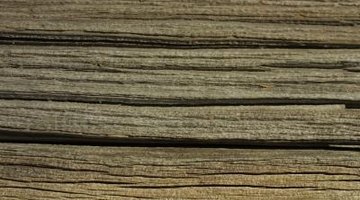How to Read Grain Direction in Wood
Whenever you are cutting, sanding, painting or staining wood, knowing the direction in which the grain of the wood travels is vital to success. Performing any of these tasks against the grain of the wood will create an uneven, rough and unattractive finish that will mar the surface of whatever you intend to use the wood for. However, determining the direction of the grain is not always as simple as just looking at the surface of the wood; reading the grain requires careful attention to detail.
By Eye

-
Set the piece of wood on a flat surface with the face that you want to cut, plane, sand, stain or paint facing upward.
-
Lower your head so that your eyes are on the same level as the piece of wood. If the edge of the board that you are near appears rough or marred by past cutting attempts, smooth it over with a plane or a piece of fine-grit sandpaper so that you can see the grain clearly.
-
Run your eyes along the edge of the board. Follow the general direction of the age lines in the wood. This tells you the general direction of the grain of the wood. The grain may be interrupted by knots or burls; don't follow the grain into those deformities, but rather through the board as a whole.
With a Square
-
Set the board down as instructed above. Locate a strong grain line at one edge of the piece of wood.
-
Lay a combination square, available from hardware and home improvement stores, running along the line you picked out.
-
Push the square in one direction along the line you chose and then carefully examine the wood you ran over. If the wood is tacky or rough, or features small splinters sticking up from where you rubbed, you were working against the grain. If it remains smooth, you were working with the grain. Either way, you know which direction it runs.
References
Tips
- Not all wood is easy to read; some features so many deformities that the grain seems completely random. If you are unsure about the grain of your wood, contact a woodworker, contractor or a professional at a hardware or home improvement store for help.
Writer Bio
Samantha Volz has been involved in journalistic and informative writing for over eight years. She holds a bachelor's degree in English literature from Lycoming College, Williamsport, Pennsylvania, with a minor in European history. In college she was editor-in-chief of the student newspaper and completed a professional internship with the "Williamsport Sun-Gazette," serving as a full-time reporter. She resides in Horsham, Pennsylvania.
Photo Credits
- Photos.com/Photos.com/Getty Images
More Articles



